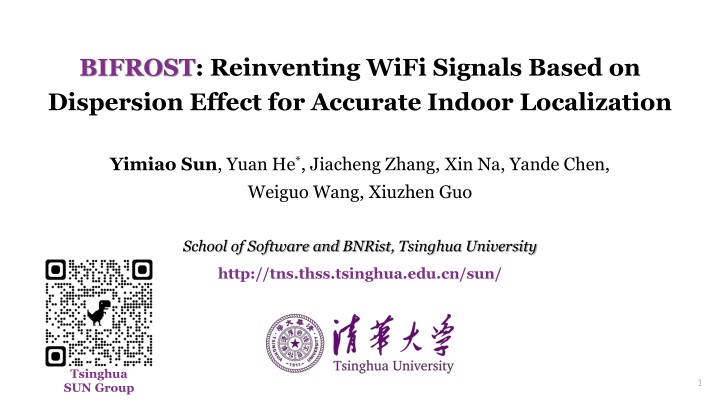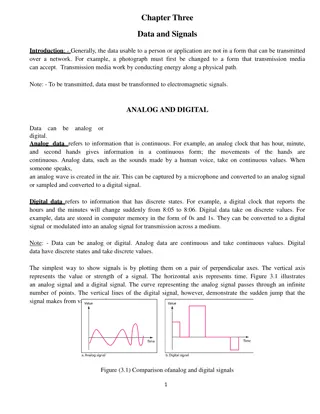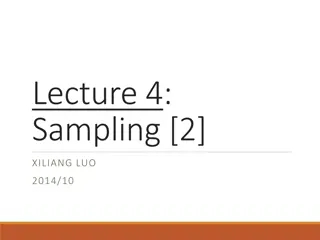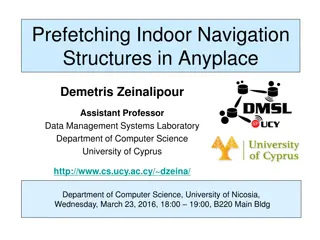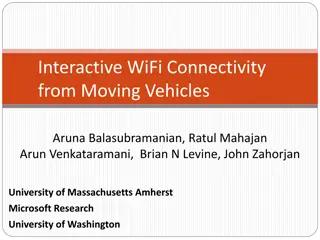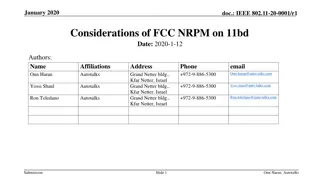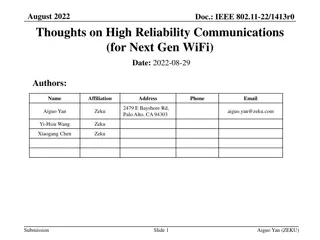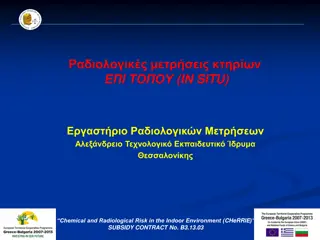Reinventing WiFi Signals for Accurate Indoor Localization with BIFROST
This research by the Tsinghua SUN Group introduces BIFROST, a novel approach that reinvents WiFi signals based on dispersion effect to enable precise indoor localization. The study addresses the challenge of limited line-of-sight (LoS) access points in indoor environments through Frequency and Spatial Division Multiplexing (FSDM) techniques, aiming to create LoS paths for improved localization accuracy.
Download Presentation

Please find below an Image/Link to download the presentation.
The content on the website is provided AS IS for your information and personal use only. It may not be sold, licensed, or shared on other websites without obtaining consent from the author.If you encounter any issues during the download, it is possible that the publisher has removed the file from their server.
You are allowed to download the files provided on this website for personal or commercial use, subject to the condition that they are used lawfully. All files are the property of their respective owners.
The content on the website is provided AS IS for your information and personal use only. It may not be sold, licensed, or shared on other websites without obtaining consent from the author.
E N D
Presentation Transcript
BIFROST: Reinventing WiFi Signals Based on Dispersion Effect for Accurate Indoor Localization Yimiao Sun, Yuan He*, Jiacheng Zhang, Xin Na, Yande Chen, Weiguo Wang, Xiuzhen Guo School of Software and BNRist, Tsinghua University http://tns.thss.tsinghua.edu.cn/sun/ Tsinghua SUN Group 1
Indoor WiFi Localization: LoS vs. NLoS Ideal Scenario Practical Scenario Problem: Indoor blockages are everywhere, so the WiFi APs in LoS scenarios may be rare. 2 Motivation
Most Indoor Rooms Cant See any LoS AP Library (48 rooms) Office (54 rooms) Less than 5% rooms can see sufficient LoS APs in our real-world investigations. 3 Motivation
Most Indoor Rooms Cant See any LoS AP How to localize a device when LoS APs are insufficient? Library (48 rooms) Office (54 rooms) The chance to receive sufficient LoSsignals is less than 5% in our real-world investigations 4 Motivation
Our Solution Solution: Reinventing the ambient WiFi signals to create the LoS paths for indoor localization. 5 BIFROST
Key Technique Basic Idea Frequency and Spatial Division Multiplexing (FSDM) 1. Employ two LWAs to radiate FSDM signals 2. Capture frequencies of the two FSDM signals ? ? ??? ? ? = ?????? 3. Estimate AoAs and location by finding the frequencies with the highest energy. Leaky Wave Antenna (LWA): Signals with different frequencies will be radiated to different directions. 6 BIFROST
BIFROST High-level Principle Frequency and Spatial Division Multiplexing (FSDM) ? ? = ?????? Where there is WiFi signal, one can be localized. ? ? ??? 7 BIFROST
Challenges Challenge 2 Challenge 1 Challenge 3 How to mitigate the indoor multipath effect? How to distinguish the two different LWAs? How to extract FSDM signal from WiFi signal? FSDM and WiFisignals operate within the same band, leading to interference. Different locations obtain the same frequencies, causing location ambiguity. Indoor multipath effect affects the quality of receiving the FSDM signals. 8 Challenge
Challenges Challenge 2 Challenge 1 Challenge 3 How to mitigate the indoor multipath effect? How to distinguish the two different LWAs? How to extract FSDM signal from WiFi signal? FSDM and WiFisignals operate within the same band, leading to interference. Different locations obtain the same frequencies, causing location ambiguity. Indoor multipath effect affects the quality of receiving the FSDM signals. 9 Challenge
Challenges Challenge 2 Challenge 1 Challenge 3 How to mitigate the indoor multipath effect? How to distinguish the two different LWAs? How to extract FSDM signal from WiFi signal? FSDM and WiFisignals operate within the same band, leading to interference. Different locations obtain the same frequencies, causing location ambiguity. Indoor multipath effect affects the quality of receiving the FSDM signals. 10 Challenge
How to distinguish the two different LWAs? Ambiguity between Different LWAs The same spectrums Different locations Problem: Another signal property, besides frequency, must be explored to distinguish the two LWAs 11 Design
Signal Polarization Polarization Mismatch Solution: Exploiting orthogonal polarization to cancel the ambiguity between the two different LWAs 12 Design
Signal Polarization LHCP is orthogonal to RHCP RHCP LHCP Polarization Mismatch Solution: Exploiting orthogonal circular polarization (LHCP & RHCP) to cancel the ambiguity between the two different LWAs 13 Design
CPLWA Design General View of CPLWA CP signal synthesis Unit Layered structure Complete design CPLWA: Orthogonal circular polarized signals can be generated by switching the signal feed port. The emitted signal is both CP and FSDM 14 Design
How to extract FSDM signal from WiFi signal? Signal Extraction from the Interfered Frequency Band Overlapped noisy spectrum WiFi and FSDM signals in the same space Problem: FSDM signals and WiFi signals operate within the same frequency band, so they may interfere with each other. 16 Design
Duty-cycled Operating Manner Identify CP Signals by Duty-cycled Operating Manner Solution: LWAs are periodically turned on and off to identify frequencies corresponding to the CP signal by analyzing the variation of received spectrum. 17 Design
How to mitigate the indoor multipath effect ? Indoor Multipath Effect Distorted received spectrum Undesired reflection Problem: The multipath effect in the indoor environment may seriously affect the quality of the received FSDM signals and the localization accuracy. 18 Design
Clustering and Filtering Multipath Signals Workflow of Selecting Correct Frequencies 1. Cluster the selected subcarriers corresponding to CP signals 2. Find the cluster with the highest integrated energy 3. Align subcarriers bearing the highest energy in reserved clusters of RHCP and LHCP signals 4. Keep the common part of clusters 5. Multiply the two reserved sequences to form a matrix and output the weighted average value of the matrix. For more detail, please refer to our paper. 19 Design
Implementation Hall and Classroom Scenarios The Realistic AP Deployment (Hall: 6.2 m 4.5 m) (Classroom: 10.6 m 7.1 m) Localized Target and the LWA (Frequency Band: 5.17 GHz ~ 5.33 GHz) 20 Evaluation
Overall Performance The Realistic AP Deployment Hall Corridor Meeting Room Classroom The median error of BIFROST is 0.81m, 52.35% less than that of SpotFi in the arguably realistic indoor settings. 21 Evaluation
Performance in NLoS The NLoS AP outdoors The NLoS AP indoors Performance comparison BIFROST provides stable performance when the AP is in LoS and NLoS. In NLoS scenarios, BIFROST achieves more accurate results than SpotFi. 22 Evaluation
Performance Enhancement BIFROST can enhance localization accuracy of existing localization techniques and achieve 33.54% error reduction (From 1.70m to 1.13m). 23 Evaluation
Impacting Factors Distance between AP and LWAs Transmission power These factors influence BIFROST s performance differently, yet the absolute accuracy never degrades drastically. 25 Evaluation
Impact on Communication Impact on the AP and the target Impact on other WiFi connections BIFROST has a negligible impact on the communication quality of either the link between the AP and the target or other WiFi connections. 26 Evaluation
Conclusion BIFROST tackles a significant problem, namely the limited availability of LoS signals, to enhance the availability of indoor WiFi locali- zation. The key innovation is the exploration of the signal polarization and dispersion effect, which embodies the concept of RF computing. BIFROST can either improve the performance of other methods, or operate independently to outperform the STOA, without affecting the ongoing data communication of WiFi networks. 27 Conclusion
BIFROST Thank You! Please find more details in: http://tns.thss.tsinghua.edu.cn/sun/ https://yimiao-sun.github.io/ 28
